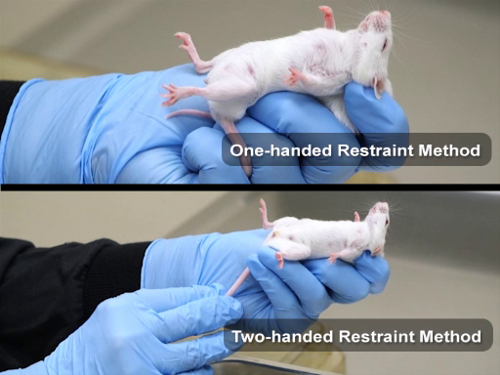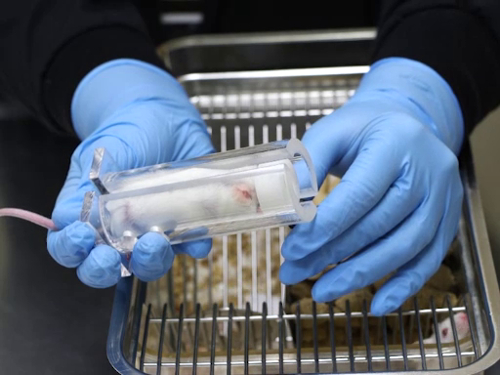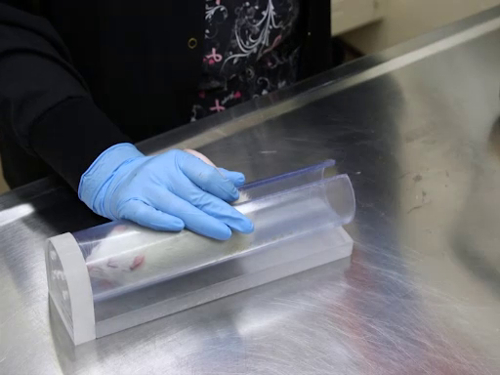설치류 취급 및 통제 기술
Overview
출처: 케이 스튜어트, RVT, RLATG, CMAR; 발레리 A. 슈뢰더, RVT, RLATG. 노틀담 대학교, IN
쥐와 쥐의 최소한의 취급조차도 동물에게 스트레스가 된다는 것이 입증되었습니다. 케이지 변경 및 기타 비침습적 절차에 대한 취급은 심박수, 혈압 및 혈청 코르티코스테론 수준과 같은 기타 생리적 매개 변수의 증가를 유발합니다. 변동은 최대 몇 시간 동안 계속될 수 있습니다. 주사와 혈액 철수에 필요한 구속의 방법은 또한 잠재적으로 과학적 데이터에 영향을 미칠 수 있는 생리적 변화를 일으킬. 쥐와 쥐의 적절 한 처리에 훈련 동물에 미치는 영향을 최소화 하는 데 필요한. 1 마우스와 쥐는 구속 장치 또는 화학 물질로 수동으로 억제 할 수 있습니다. 수동 메서드 및 구속 장치 사용은 이 원고에서 다룹니다. 모든 구속 방법은 자신의 홈 케이지에서 동물을 들어 올리는 과정을 포함한다.
Procedure
1. 스크러핑
마우스는 가장 자주 스크러핑 기술을 사용하여 억제되지만 어린 쥐는이 방법으로 억제 될 수 있습니다. 성인 쥐는 더 근육 목, 느슨한 피부의 감소 된 양, 그리고이 방법에 대한 혐오로 인해이 기술로 억제하기가 더 어렵습니다.
- 한 손 구속 방법은 자위혈 누드, SCID 및 일부 GEM 균주와 같이 매우 차분한 마우스 균주에서 가장 자주 활용됩니다. 그러나 이 메서드에 물린 위험이 더 큽습니다. 초보 동물 처리기는 한 손으로 방법을 시도하기 전에 양손 구속 기술에 익숙해져야합니다.
- 와이어 바 케이지 상단이나 매트와 같이 동물을 잡을 수 있는 표면에 놓습니다.
- 지배적이지 않은 손의 세 번째 손가락과 네 번째 손가락 사이에 꼬리를 잡고 부드러운 뒤로 견인을 적용합니다. 이로 인해 동물이 표면을 붙잡고 몸이 늘어나고 길어지게 됩니다.
- 손바닥이 동물의 몸을 향할 수 있도록 손을 돌린다.
Application and Summary
References
- Balcombe, J.P., Barnard, N.D., and Sandusky, C. 2004. Laboratory routines cause animal stress. Contemporary Topics. 43:6. 42-51
- Gouveia, K. and Hurst, J.L. 2013. Reducing mouse anxiety during handling: effect of experience with handling tubes.
- AALAS Learning Library*. Animal handling and restraint in: Working with the laboratory rat. https://www.aalaslearninglibrary.org/Pages/Courses/CourseAllPages.aspx?intLessonID=27691
- AALAS Learning Library*. Animal handling and restraint in: Working with the laboratory mouse. https://www.aalaslearninglibrary.org/Pages/Courses/course.aspx?intCourseID=2451&intPageID=94993
*A membership or trial sign up is required to view the material.
건너뛰기...
이 컬렉션의 비디오:

Now Playing
설치류 취급 및 통제 기술
Lab Animal Research
174.2K Views

실험실 기본 관리
Lab Animal Research
27.9K Views

사육 및 이유의 기초
Lab Animal Research
35.7K Views

설치류 식별 I
Lab Animal Research
54.7K Views

설치류 식별 II
Lab Animal Research
25.6K Views

화합물 투여 I
Lab Animal Research
100.4K Views

화합물 투여 II
Lab Animal Research
34.8K Views

화합물 투여 III
Lab Animal Research
31.4K Views

화합물 투여 IV
Lab Animal Research
51.6K Views

혈액 채취 I
Lab Animal Research
171.5K Views

혈액 채취 II
Lab Animal Research
73.1K Views

마취 유도 및 유지
Lab Animal Research
50.4K Views

설치류 수술에 대한 고려 사항
Lab Animal Research
22.4K Views

진단 부검 및 조직 수확
Lab Animal Research
58.0K Views

멸균 조직 수확
Lab Animal Research
34.8K Views
Copyright © 2025 MyJoVE Corporation. 판권 소유





